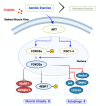Effects of exercise on AKT/PGC1-α/FOXO3a pathway and muscle atrophy in cisplatin-administered rat skeletal muscle
- PMID: 34697269
- PMCID: PMC8552830
- DOI: 10.4196/kjpp.2021.25.6.585
Effects of exercise on AKT/PGC1-α/FOXO3a pathway and muscle atrophy in cisplatin-administered rat skeletal muscle
Abstract
Cisplatin has been reported to cause side effects such as muscle wasting in humans and rodents. The physiological mechanisms involved in preventing muscle wasting, such as the regulation of AKT, PGC1-α, and autophagy-related factor FOXO3a by MuRF 1 and Atrogin-1, remain unclear following different types of exercise and in various skeletal muscle types. Eight-week-old male Wistar rats (n = 34) were assigned to one of four groups: control (CON, n = 6), cisplatin injection (1 mg/kg) without exercise (CC, n = 8), cisplatin (1 mg/kg) + resistance exercise (CRE, n = 9) group, and cisplatin (1 mg/kg) + aerobic exercise (CAE, n = 11). The CRE group performed progressive ladder exercise (starting with 10% of body weight on a 1-m ladder with 2-cm-interval grids, at 85°) for 8 weeks. The CAE group exercised by treadmill running (20 m/min for 60 min daily, 4 times/week) for 8 weeks. Compared with the CC group, the levels of the autophagy-related factors BNIP3, Beclin 1, LC3-II/I ratio, p62, and FOXO3a in the gastrocnemius and soleus muscles were significantly decreased in the CRE and CAE groups. The CRE and CAE groups further showed significantly decreased MuRF 1 and Atrogin-1 levels and increased phosphorylation of AKT, FOXO3a, and PGC1-α. These results suggest that both ladder and aerobic exercise directly affected muscle wasting by modulating the AKT/PGC1-α/FOXO3a signaling pathways regardless of the skeletal muscle type.
Keywords: Autophagy; Cisplatin; Exercise training; Muscle atrophy; Skeletal muscle.
Conflict of interest statement
The authors declare no conflicts of interest.
Figures





Similar articles
-
Exercise-Induced Autophagy Suppresses Sarcopenia Through Akt/mTOR and Akt/FoxO3a Signal Pathways and AMPK-Mediated Mitochondrial Quality Control.Front Physiol. 2020 Nov 2;11:583478. doi: 10.3389/fphys.2020.583478. eCollection 2020. Front Physiol. 2020. PMID: 33224037 Free PMC article.
-
Effect of acute treadmill exercise on cisplatin-induced muscle atrophy in the mouse.Pflugers Arch. 2017 Nov;469(11):1495-1505. doi: 10.1007/s00424-017-2045-4. Epub 2017 Jul 31. Pflugers Arch. 2017. PMID: 28762162
-
Alteration of Autophagy Gene Expression by Different Intensity of Exercise in Gastrocnemius and Soleus Muscles of Wistar Rats.J Sports Sci Med. 2019 Feb 11;18(1):146-154. eCollection 2019 Mar. J Sports Sci Med. 2019. PMID: 30787662 Free PMC article.
-
A Preclinical Systematic Review of the Effects of Chronic Exercise on Autophagy-Related Proteins in Aging Skeletal Muscle.Front Physiol. 2022 Jul 14;13:930185. doi: 10.3389/fphys.2022.930185. eCollection 2022. Front Physiol. 2022. PMID: 35910582 Free PMC article.
-
HDL Mimetics Enhances Mitochondrial Function via Stimulation of PGC1-α.Eur Cardiol. 2023 Apr 25;18:e27. doi: 10.15420/ecr.2023.18.PO10. eCollection 2023. Eur Cardiol. 2023. PMID: 37405353 Free PMC article. Review. No abstract available.
Cited by
-
High-intensity interval training alleviates exhaustive exercise-induced HSP70-assisted selective autophagy in skeletal muscle.J Physiol Sci. 2023 Nov 21;73(1):32. doi: 10.1186/s12576-023-00884-2. J Physiol Sci. 2023. PMID: 37990150 Free PMC article.
-
Targeting Mitochondria and Oxidative Stress in Cancer- and Chemotherapy-Induced Muscle Wasting.Antioxid Redox Signal. 2023 Feb;38(4-6):352-370. doi: 10.1089/ars.2022.0149. Epub 2022 Dec 29. Antioxid Redox Signal. 2023. PMID: 36310444 Free PMC article. Review.
-
PGC1α overexpression preserves muscle mass and function in cisplatin-induced cachexia.J Cachexia Sarcopenia Muscle. 2022 Oct;13(5):2480-2491. doi: 10.1002/jcsm.13035. Epub 2022 Jul 28. J Cachexia Sarcopenia Muscle. 2022. PMID: 35903870 Free PMC article.
-
Physical Activity as the Best Supportive Care in Cancer: The Clinician's and the Researcher's Perspectives.Cancers (Basel). 2022 Nov 2;14(21):5402. doi: 10.3390/cancers14215402. Cancers (Basel). 2022. PMID: 36358820 Free PMC article. Review.
-
Activating Striatal Parvalbumin Interneurons to Alleviate Chemotherapy-Induced Muscle Atrophy.J Cachexia Sarcopenia Muscle. 2025 Apr;16(2):e13782. doi: 10.1002/jcsm.13782. J Cachexia Sarcopenia Muscle. 2025. PMID: 40196908 Free PMC article.
References
-
- Fearon K, Strasser F, Anker SD, Bosaeus I, Bruera E, Fainsinger RL, Jatoi A, Loprinzi C, MacDonald N, Mantovani G, Davis M, Muscaritoli M, Ottery F, Radbruch L, Ravasco P, Walsh D, Wilcock A, Kaasa S, Baracos VE. Definition and classification of cancer cachexia: an international consensus. Lancet Oncol. 2011;12:489–495. doi: 10.1016/S1470-2045(10)70218-7. - DOI - PubMed
-
- Galluzzi L, Baehrecke EH, Ballabio A, Boya P, Bravo-San Pedro JM, Cecconi F, Choi AM, Chu CT, Codogno P, Colombo MI, Cuervo AM, Debnath J, Deretic V, Dikic I, Eskelinen EL, Fimia GM, Fulda S, Gewirtz DA, Green DR, Hansen M, et al. Molecular definitions of autophagy and related processes. EMBO J. 2017;36:1811–1836. doi: 10.15252/embj.201796697. - DOI - PMC - PubMed
LinkOut - more resources
Full Text Sources
Research Materials

